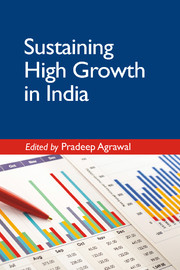Book contents
- Frontmatter
- Contents
- List of Tables
- List of Graphs and Maps
- Preface
- Introduction
- Section 1 Ensuring Macroeconomic Stability for Sustaining High Growth Rates
- Section 2 Promoting Industrial Development for Sustaining High Growth Rates
- 3 Economic Complexity as a Determinant of Industrialization of Countries: The Case of India
- 4 China's Manufacturing Success: Lessons for India
- 5 Sustaining India's Manufacturing Sector Growth in the Face of Increasing Competition from Chinese Imports
- Section 3 The International Economic Issues and Sustaining High Growth
- Section 4 Infrastructure Bottlenecks to Sustaining High Growth
- Section 5 Some Socio-political Issues in Sustaining High Growth
- List of Contributors
- Obituary
- Index
5 - Sustaining India's Manufacturing Sector Growth in the Face of Increasing Competition from Chinese Imports
from Section 2 - Promoting Industrial Development for Sustaining High Growth Rates
Published online by Cambridge University Press: 08 February 2018
- Frontmatter
- Contents
- List of Tables
- List of Graphs and Maps
- Preface
- Introduction
- Section 1 Ensuring Macroeconomic Stability for Sustaining High Growth Rates
- Section 2 Promoting Industrial Development for Sustaining High Growth Rates
- 3 Economic Complexity as a Determinant of Industrialization of Countries: The Case of India
- 4 China's Manufacturing Success: Lessons for India
- 5 Sustaining India's Manufacturing Sector Growth in the Face of Increasing Competition from Chinese Imports
- Section 3 The International Economic Issues and Sustaining High Growth
- Section 4 Infrastructure Bottlenecks to Sustaining High Growth
- Section 5 Some Socio-political Issues in Sustaining High Growth
- List of Contributors
- Obituary
- Index
Summary
INTRODUCTION
The context
The prime goal of the National Manufacturing Policy, 2011, is to raise the share of manufacturing in India's GDP by about 10 percentage points between 2012 and 2022, making manufacturing GDP reach about a quarter of the aggregate GDP by 2022. For fulfilling this objective, a rapid growth in the output of the Indian manufacturing in the coming years at a rate of about 10 per cent or higher per year is necessary. An important initiative taken by the government is the ‘Make in India’ programme, which was launched in September 2014. The programme is directed at promoting a manufacturing-led economic growth in India. It focuses on policy initiatives to develop infrastructure, improve ‘ease of doing business’ and undertake reforms of the currently existing labour regulations to impart greater flexibility in the industrial labour markets. Some other associated aspects of the programme are the initiatives towards protection of intellectual property rights and development of skills among the Indian workers.
The current policy thrust for attaining accelerated growth of Indian manufacturing seems to be mostly directed at the supply-side constraints on growth. Arguably, Indian manufacturing is facing demand-side problems also and these problems may pose a serious challenge to the sustenance of a high rate of growth in manufacturing. This chapter deals with one demand-side problem, namely, increasing penetration of Chinese imports into markets for industrial products in India. It is needless to say that this factor can potentially have a serious adverse effect on the growth performance of Indian manufacturing, and therefore, needs a careful analysis.
Banga (2014) has argued that Indian manufacturing has been experiencing some degree of ‘hollowing-out’, manifested in a downward trend in the ratio of value added to output in the manufacturing sector. She ascribes this phenomenon to the intense import competition faced by the Indian manufacturing firms thanks to India's import liberalization, particularly from imports from China. She notes that a downward trend in value added share in the output of manufacturing, as observed, could arise from increasing cost of energy input in manufacturing. But, in the case of India, this does not apply as there has been a clear downward trend in energy cost as a ratio to the manufacturing sector output. Thus, this factor does not explain the observed fall in the share of the value added in the output in manufacturing.
- Type
- Chapter
- Information
- Sustaining High Growth in India , pp. 147 - 174Publisher: Cambridge University PressPrint publication year: 2017



